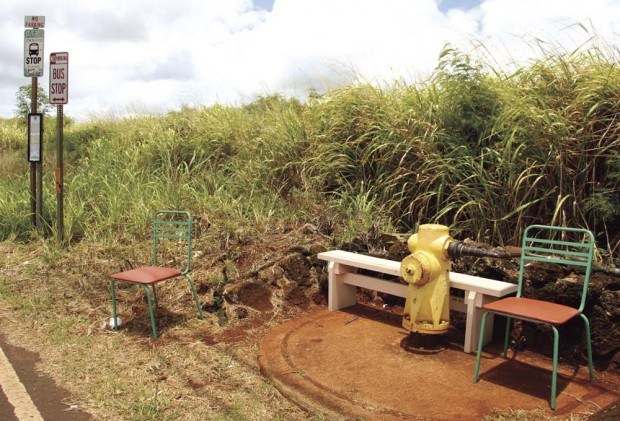NAWILIWILI — A roof over your head — plus a bike rack, trash can and lighting — while you wait for the bus could cost taxpayers $50,000. County Transportation Executive Celia Mahioka told Kaua‘i County Council members during a budget
NAWILIWILI — A roof over your head — plus a bike rack, trash can and lighting — while you wait for the bus could cost taxpayers $50,000.
County Transportation Executive Celia Mahioka told Kaua‘i County Council members during a budget review session April 25 that the agency is requesting $250,000 for Fiscal Year 2012 to build five bus stop shelters.
The shelters will have seating and, if necessary, solar lighting, bicycle racks and trash receptacles. The ideal would be to build the shelters in the most sustainable way, she said.
The county is projecting to collect $750,000 in revenues for the Kaua‘i Bus in FY12, which starts July 1. This represents a five-fold increase since 2003. But out of the 124 bus stops islandwide, only seven have county-provided shelters, county officials said.
An extra 29 stops are in established facilities that wouldn’t require shelters, such as the one in Wilcox Memorial Hospital in Lihu‘e, according to Mahikoa. This would leave 88 bus stops, or 71 percent, in need of shelters.
The agency is still taking preliminary steps, she said, such as conducting analysis on ridership and on current facilities, plus checking how it can obtain authorization from private land owners, the county or state.
“We are going rather conservatively,” said Mahioka, noting that this is the first time that the agency is doing a project that would cover design costs, building and supplies for amenities.
While the initial goal is building five shelters over the course of the next fiscal year, the agency intends to try to build as many as it can, she said.
The City and County of Honolulu has a complex public transportation system called The Bus, touted by Honolulu Mayor Peter Carlisle as “Honolulu’s award-winning bus service.”
Mahioka said the Kaua‘i agency is working with Honolulu in order to get shelter-design feedback, which would be “a lot better than reinventing the wheel.”
The Honolulu administration is willing to work with Kaua‘i’s Transportation Agency, according to Mahioka.
The agency is doing initial assessment of areas where bus shelters are most needed, including how many boardings occur in different locations. The bus drivers are also involved in the input process. However, the areas of greatest need may have some restrictions, she said.
The agency will go after locations that would require the least amount of development, Mahioka said. “That’s what we are going to prioritize.”
Some of the challenges include limited space to build a shelter and negotiation with landowners. Kaua‘i’s rural transit nature also creates a connectability challenge, Mahioka said. The bus shelters can be built with accessible features, but making sure everyone gets safe access to the shelters is a challenge.
Many community groups such as the Lyons Club are willing to work with the agency as far as maintaining facilities, she said.
“We are looking forward to making public transit system more attractive for users,” Mahioka said.
The entire proposed operating budget for the agency for FY12 — including salaries, wages, benefits, operations, equipment and leases — is $5.5 million, up from $4.6 million for the current year.
The funding for the shelters falls under the budget for Capital Improvement Projects.
The county’s entire proposed CIP budget — including all county agencies’ projects for FY12 — is $84.69 million, down from $100 million for the current fiscal year.
The main reason the proposed FY12 CIP budget reflects a reduction is because the administration decided to allocate funds only for those projects that would be initiated within 12 to 18 months, according to county Managing Director Gary Heu.
Go to www.kauai.gov/transportation for more information.
• Léo Azambuja, staff writer, can be reached at 245-3681 (ext. 252) or lazambuja@ thegardenisland.com.


